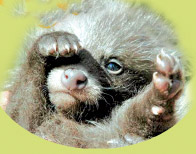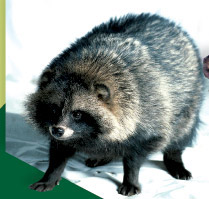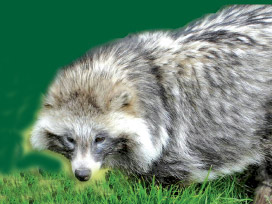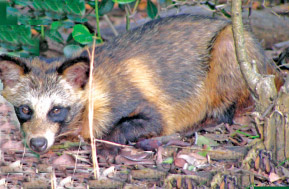|
Nature Trail:

The animal kingdom is indeed full of beautiful, exotic, bizarre,
weird and awesome creatures with names which are equally fascinating as
their appearance. Some of
  the
names by which these unique animals are identified especially those that
comprise names of two entirely different species, are so mind boggling
that it makes one wonder whether such creatures truly exist. Can you
imagine animals such as cat snakes, cattle egrets, spider monkeys, tiger
butterflies or sea horses really existing? They do, but their appearance
is not a mix of the two creatures. the
names by which these unique animals are identified especially those that
comprise names of two entirely different species, are so mind boggling
that it makes one wonder whether such creatures truly exist. Can you
imagine animals such as cat snakes, cattle egrets, spider monkeys, tiger
butterflies or sea horses really existing? They do, but their appearance
is not a mix of the two creatures.
Today we focus on one such animal which is bound to capture your
attention by its rather unusual name. Even though you may have heard of
raccoons, and dogs may be even a part of some of your lives, as your
most beloved pets, many of you may not have heard of raccoon dogs.
The Raccoon Dog (Nyctereutes procyonoides), is a member of the
canidae family which includes man's best friend-the dog, wolves and
foxes. However, the raccoon, dog is not a true dog and is the only
species in its genus. It is also not related to the raccoon, but its
strong resemblance to the non canid raccoon has resulted in it being
given the name, which naturally arouses our curiosity when we hear it.
Its scientific name has originated from the Greek words nukt which means
night, ereutes which stands for wanderer and prokuon which means before
dog. In New Latin it means raccoon.
As the raccoon dog is indigenous to east Asia, it is found in Japan,
southeastern Siberia, and Manchuria. But now its range goes as far as
Scandinavia and France. About five years ago sightings have been
reported from Italy too. The animal carries historical and cultural
significance in Japan, and is also known under the Japanese name tanuki.
 The
average adult head and body length of a raccoon dog is about 65 cm (2
ft) Its weight ranges from 4 to 10 kg (9 to The
average adult head and body length of a raccoon dog is about 65 cm (2
ft) Its weight ranges from 4 to 10 kg (9 to 22 lb), and fluctuates according to the season; in March, it weighs
about three kg (6.6 lbs). In August to early September, males average
6.5-7 kg (14-15 lbs), with some individuals attaining a maximal weight
of 9-10 kg (20-22 lbs). It has a long torso with short legs and a short
tail which amounts to less than 1/3 of the animal's total length. It
hangs down without touching the ground.
22 lb), and fluctuates according to the season; in March, it weighs
about three kg (6.6 lbs). In August to early September, males average
6.5-7 kg (14-15 lbs), with some individuals attaining a maximal weight
of 9-10 kg (20-22 lbs). It has a long torso with short legs and a short
tail which amounts to less than 1/3 of the animal's total length. It
hangs down without touching the ground.
The ears are short, and protrude only slightly from the fur which is
a bright and reddish-straw colour in the summer and a dirty, earth-brown
or brownish-grey colour with black guard hairs in the winter. The tail
is darker than the torso. A dark stripe is present on the back which
broadens on the shoulders, forming a cross shape. The fur on the abdomen
is yellowish-brown, while the chest area is dark brown or blackish. The
coat of fur is long and thick with dense underfur and coarse guard hairs
measuring 120 mm in length in winter. This winter fur protects the
raccoon dog from low temperatures that can go below 20 degrees. The
muzzle is covered in short hair, which increases in length and quantity
behind the eyes.
The cheeks are coated with long whisker-like hairs. Its teeth are
small . It does not bark like foxes, uttering instead a growl, followed
by a long-drawn sad sounding whine. Captive specimens have been known to
utter a very different kind of sound when hungry, described as a sort of
mewing plaint. Males fighting for females will yelp and growl. Japanese
raccoon dogs produce sounds higher in pitch than those of domestic dogs,
and sound similar to cats.
The Raccoon dog is considered to be a unique member of the canid
family due to many reasons. It is also unique because its curved claws
enable it to climb trees; the only other member of the canid family with
this ability is the grey fox. It is the only member to go into torpor
(non active stage) through the winter months. In early winter it
increases its subcutaneous fat by 18-23 per cent and its internal fat by
three per cent. An animal failing to reach these fat levels usually does
not survive the winter period. . In December, its physical activity
decreases once snow depth reaches 15-20 cm. It will not vacate its
burrows for more than 150-200 metres. It is only in February when food
is available and females too are ready for reproduction that its daily
activities increase. Males will fight briefly and non-fatally for mates.
 The
pups are born in April-May. Litter sizes on average consist of 6-7 cubs,
though 15-16 pups can be born in exceptional cases. First time mothers
typically give birth to fewer pups than older ones. Males take an active
role in raising the pups. When the cubs are born after a gestation of
about 60 days, the male will assist in cub-rearing, first by providing
food to his mate and then also for the cubs when they are weaned, about
50 days after they are born. The
pups are born in April-May. Litter sizes on average consist of 6-7 cubs,
though 15-16 pups can be born in exceptional cases. First time mothers
typically give birth to fewer pups than older ones. Males take an active
role in raising the pups. When the cubs are born after a gestation of
about 60 days, the male will assist in cub-rearing, first by providing
food to his mate and then also for the cubs when they are weaned, about
50 days after they are born.
At birth, pups weigh 60-110 grams, and are blind and covered in
short, dense, soft wool lacking guard hairs. The guard hairs begin to
grow only after 10 days, and first appear on the hips and shoulders.
After two weeks, they lighten in colour, with black tones remaining only
around the eyes. Their eyes open after 9-10 days, with the teeth
erupting after 14-16 days, Lactation lasts for 45-60 days, though pups
will begin eating food brought to them as early as the age of three
weeks or one month. They reach their full growth at the age of 4.5
months.
Pups will leave their parents in late August-September. By October,
the pups, which by then resemble adults, will unite in pairs. Sexual
maturity is reached at 8-10 months. Their longevity is largely unknown;
animals 6-7 years of age have been encountered in the wild, while
captive specimens have been known to live for 11 years.
Raccon dogs are found in both plains and mountainous regions and are
especially common in woodlands. They are commonly seen near villages and
in rural areas, Being rather secretive and not very aggressive animals
they prefer to hide or scream rather than fight, and play possum or
dead, to avoid predators.
Like many other canines, the raccoon dog too is omnivorous. However,
its diet is atypically diverse, comprising invertebrates, frogs,
lizards, rodents and birds along with seeds and berries. Those living
near the ocean however will also eat crabs and scavenge marine life. In
general it feeds on insects, mouse-like rodents, amphibians, birds,
fish, reptiles, molluscs, carrion and insectivores.
The raccoon dog will modify its diet seasonally; in late autumn and
winter, it will feed mostly on rodents, carrion and faeces, while fruit,
insects and amphibians predominate in spring. In summer it will eat less
rodents, and mainly target nesting birds and fruits, grains and
vegetables.
-Facts and pix: Internet
***********
Fact file
* It turns its tail into an inverted U to express dominance.
* It is considered a basal canid species
* It is also known as the Magnut
* The brain of this creature is poorly developed compared to dogs and
wolves
* There is some debate in the scientific community regarding
speciation between the Siberian subspecies (N. p. ussuriensis), Chinese
subspecies (N. p. procyonoides) and the Japanese Raccoon Dog.
Due to chromosome, behaviourial and weight differences, some are of
the view that the Japanese Raccoon Dog should be considered a separate
species from the two other subspecies
* Raccoon dog populations have declined in recent years due to
hunting, urbanisation, an increase of animals associated with human
civilization such as pets and abandoned animals, and diseases that may
be transmitted between them. They are also killed for their fur in
China.
* Raccoon dog skulls greatly resemble those of South American foxes,
particularly crab eating foxes, though genetic studies reveal they are
not closely related.
* Raccoon dogs carry 32 different parasitic worms.
* From 1928-1958, 10 thousand raccoon dogs of the ussuriensis
subspecies were introduced in 76 districts, territories and republics of
the Soviet Union in an attempt to improve their fur quality.
* The raccoon dog is now abundant throughout Finland, Estonia,
Latvia, and Lithuania, and has been reported as far away as Serbia,
France, Romania, Italy, Switzerland, Germany, Norway, Denmark, and
Sweden.
* Wolves are the most important predators of raccoon dogs, killing
large numbers of them in spring and summer, though attacks have been
reported in autumn too. Red foxes will kill raccoon dog pups, and have
been known to bite adults to death. Both foxes and Eurasian badgers
compete with raccoon dogs for food, and have been known to kill them if
raccoon dogs enter their burrows. Eurasian lynxes rarely attack them,
due to their low numbers. Birds of prey known to prey on raccoon dogs
include golden eagles, white tailed eagles, goshawks and eagle owls
Raccoon dogs are harmful to game bird populations, particularly in
floodlands and the shorelines of estuaries where they feed almost
exclusively on eggs and chicks during the spring period.
* Raccoon dogs are typically hunted from November until the snow
deepens
* About 18,000-70,000 Japanese raccoon dogs were killed in Japan from
the post-WWII period to 1982. Japan has intensified its raccoon dog
culling since the 1970s, averaging 4,529 kills annually between
1990-1998. Harvests have since decreased. |

